What is Google Cloud Platform?
Google Cloud Platform is a cloud computing service. It is not a singular service. It is a complete suite that spans over different services like compute, Big Data, networking, storage, and many more.
The infrastructure that Google provides is the same infrastructure that it uses for providing services like YouTube and Google Search. What makes Google Cloud Platform ultra-reliable is that its servers have not gone down in several years.
So, whether you are running a simple website or an app on Google Cloud Platform, you can rest assured that your applications are secure and safe.
In case you are wondering what cloud computing is, it simply means storing and accessing data over the internet. You will be ditching your personal hard drive or SSD storage. With cloud computing, you can not only store data but also create databases, carry out networking, etc.
What makes cloud computing immensely popular is that it reduces costs by eliminating the need for acquiring and maintaining hardware. Customers using cloud infrastructure will pay only for the resources they use.
There are many cloud providers, and some of the biggest names include Amazon AWS, Microsoft Azure, Google Cloud, VMware Cloud, IBM Cloud, etc.
Of course, the top players in the market are Amazon, Microsoft, and Google. Google Cloud has gained immense popularity lately, and there are valid reasons for such popularity.
Google Cloud is undoubtedly one of the top cloud service providers in the IT industry. The infrastructure they provide is highly scalable and reliable. It is particularly helpful for software developers because they can easily build, test, and deploy their applications using Google Cloud.
In the 2018 Gartner Infrastructure as a Service Magic Quadrant, Google was announced as the leader in the market. Gartner compared Google with other cloud providers and identified it as one of the top three cloud providers in the market. The other two were Amazon AWS and Microsoft Azure.
Google Cloud vs. Amazon AWS vs. Microsoft Azure
Here is how the three top cloud providers stacked up against each other:
| Comparison Parameter | Google Cloud | Amazon AWS | Microsoft Azure |
| Compute | Google Cloud uses the Google Compute Engine for computation. | Core computer services are provided by AWS EC2 | Virtual machines are used by Azure for computation purposes. |
| Storage | Google Cloud uses Google Cloud Storage. | Amazon uses Amazon S3. | Azure uses storage block blobs that make up the container for storage. |
| Pricing | Google Cloud offers a customer-friendly pricing structure that is easy to understand and easily beats other providers. | Amazon AWS has an extremely complex and very granular pricing structure, making it particularly inscrutable. | It is pretty difficult to understand the pricing structure of Azure unless you have significant experience with Azure. |
Because Google Cloud has an easy to understand pricing structure, and because it provides a massively scalable storage solution, Google Cloud is often the obvious choice for cloud computing. It is really difficult to say whose compute solution is better because they are reliable in that one aspect.
Some Benefits of Using Google Cloud Platform
If you intend to use Google Cloud Platform, you will have some important benefits. They include:
Best Pricing for Hosting
You need to understand that when I am saying “best pricing for hosting,” I am not referring to options like Digital Ocean or Vultr. They are not the competitors of Google Cloud. I don’t think they will ever be.
Azure and AWS are the true competitors of Google Cloud. So, Google’s pricing is better than that of AWS and Azure. Google offers a pay-as-go pricing structure, but at a much less granular scale, making it easy to understand.
Interestingly, there is a persistent discount available with Google, making it a cheaper option. You will not get such discounts with AWS or Azure.
Private Network
Google Cloud uses its own network for the cloud platform. Customers using the platform get access to the exact same network that Google uses, giving them more control and scalability over the network.
Google uses fiber optics for its private network, which is capable of handling any amount of traffic. This ensures maximum efficiency.
Work from Anywhere
The Google-powered web applications remain accessible through any device globally as long as people have access to the internet. This allows all employees of an organization to gain complete access to the data from anywhere they want.
Security
Google has inhouse security experts working round the clock to protect all data stored on Google servers. Not just that, all data that you store on Google Cloud is encrypted. So, you can rest assured that your data will remain safe.
Redundant Backup Policy
Google Cloud Platform has a redundant backup policy, which means that Google will create a backup for all the data you store. So, even if you accidentally delete your data, it is never lost. There is always a backup copy that you can use. Thus, the built-in redundant backup feature ensures the durability, reliability, and integrity of your data.
What are the Different Services that Google Cloud Platform Offers?
Google Cloud offers a wide array of services, which makes it one of the most sought-after cloud computing platforms across the globe. The different services that Google Cloud offers are broadly categorized into the following:
- Compute
- Storage
- Networking
- Big Data
- Security Management and Identity Management
- Management Tools
- Cloud AI
- Internet of Things or IoT
Let me walk you through each of these services quickly before setting out to talk about its pricing structure and explain how you can use Google Cloud Platform. Sounds good?
Let’s start!
Compute Services
Google Cloud’s compute services have three different components. They are:
Google App Engine
The Google App Engine is a PaaS or Platform as a Service. It will allow you to deploy various applications like PHP, Java, etc. It is a platform for hosting web applications in data centers that are managed by Google.
Google App Engine allows automatic scaling, which means that when the number of requests for the web application increases, the App Engine automatically increases the resources to deal with the increased demand or traffic.
Compute Engine
The Compute Engine is an IaaS or Infrastructure as a Service. It will allow you to run Linux or Windows virtual machines. The Compute Engine is built on the same infrastructure upon which the YouTube, Google Search, and other Google services are running.
Kubernetes Engine
The Kubernetes Engine of Google Cloud, usually known as the GKE or the Google Kubernetes Engine, is a managed environment that allows management, deployment, and scaling of containerized applications using the infrastructure that Google provides. It works with docker and various other container tools.
In case you are unable to understand what it is all about, you can happily skip this because it is targeted towards developers.
Storage Services
There are three components to this as well. Those components are:
Google Cloud Storage
It is a file storage service that allows you to store and access data on Google Cloud infrastructure. It allows scalability combined with advanced security features and sharing capabilities.
Cloud SQL
It is a web service that you can use for creating, configuring, and using relational databases. These databases stay in Google Cloud, which will maintain, manage, and administer the databases to give you all the time you need for focusing on the applications and services that you develop.
Cloud Bigtable
It is a NoSQL database service that is highly scalable, very fast, and fully managed. You can use it for collecting and retaining data from as low as 1 TB to as high as several hundred PB.
Networking Services
The Networking services of Google Cloud Platform, too, offer three different components. They are:
Virtual Private Cloud
The Virtual Private Cloud or VPC will give you a private network to create a secure environment where you can deploy your apps. The network will have a network firewall, routing, and IP allocation.
Cloud Load Balancing
It is a process in which you can distribute workloads across various computing resources, reducing cost, and maximizing resource availability.
Content Delivery Network
It is a network of proxy servers and data centers that are distributed geographically. A CDN will spatially distribute the services related to end-users, ensuring high availability and high performance. You may have already come across this term, perhaps, also know about Cloudflare, which is one of the most famous CDNs in the world.
Big Data
Unless you are from the field of data analysis, things that I am going to tell you here will sound totally alien to you. So, you have a choice of skipping this section. But if you want, you can read through.
Again, there are three components. They are:
BigQuery
It is a fully managed data analysis service by Google that allows big businesses to analyze Big Data. BigQuery gives scalable storage for data, and it allows performing ad-hoc queries. You can even use BigQuery for sharing data insights using the web.
Google Cloud Datastore
It is a non-relational datastore that is schema-less, and it is a fully managed service. It comes with amazing query capabilities and supports atomic transactions. Depending on the load, it can scale up or down very quickly.
Google Cloud Dataproc
It is a Hadoop and Spark service for processing distributed data. You can create Hadoop or Spark clusters using Google Cloud Dataproc that you can size according to your needs and use them precisely when you need those clusters.
Cloud API
There are two components of Cloud AI services offered by Google Cloud Platform. They are:
Cloud Machine Learning Engine
This managed service from Google Cloud will allow you to create Machine Learning models. These models are all based on mainstream frameworks.
Cloud AutoML
This is a machine learning product. If you are a developer, you can provide your data sets to Google, giving you access to models trained by Google’s transfer learning and Neural Architecture Search.
Security Management and Identity Management
There are two things here. They are:
Cloud Data Loss Prevention API
If you have a business that receives sensitive data like passport numbers, names, credit card numbers, etc., this service is for you. It allows scalable and fast sensitive data classification.
Cloud IAM
IAM stands for Identity and Access Management. The Cloud IAM is a framework of technologies and policies that only the right people in an organization have access to technology resources. Also known as identity management or IdM, Cloud IAM is of great importance to big corporations that issue different access levels to different employees.
Management Tools
There are two management tools available with Google Cloud Platform. They are:
Google Stackdriver
This tool offers diagnostic and performance data to public cloud users. The data can be in the form of error reporting, tracing, logging, monitoring, and alerting.
Google Cloud Console App
It is a mobile application that you can download and install on your phone. You can manage important Google Cloud services through the app. The app comes with monitoring and alerting capabilities. If necessary, you can take actions on resources.
Internet of Things
There are two components of the service. They are:
Cloud IoT Core
It is a service managed completely by Google. Using this service, you can connect, manage, and ingest data from all devices that are internet-connected. You can do all this securely and even use other Google Cloud services to collect, process, analyze, and visualize data in real-time.
Cloud IoT Edge
This service brings computing power and memory closer to a location where they are needed. People also call it Edge Computing.
Who Uses Google Cloud Platform?
If you intend to build a website, you can use the cloud hosting service offered by the Google Cloud Platform. If you are a consumer of products and services, you don’t need it. That’s a micro-level talk. However, there are big organizations that use the Google Cloud Platform for different purposes.
Some of the biggest names that use the platform include PayPal, HSBC, 20th Century Fox, Twitter, eBay, LG CNS, etc.
They use the platform for different purposes.
Pricing Structure of Google Cloud Platform
In case you want to try out Google Cloud Platform, you must learn about its pricing policy. There are no fixed prices. You need to pay for whatever you use. This is called the pay-as-you-go pricing structure.
Other cloud platform providers like Microsoft Azure, Amazon AWS, etc., also follow the same model.
However, you need not pay anything to get started with Google Cloud Platform. There is something called the Google Cloud Free Tier.
Irrespective of whether you are a rookie or an expert, you can try Google Cloud Platform for free.
If you are a rookie, you can try out the platform to learn it. If you are an experienced person, you can try it to find out whether it works for you or not. The trial period lasts for 90 days, and you will get a $300 credit during the trial.
You can also opt for a free trial option, which has no time limit attached to it. So, you can keep using it forever.
As far as professional use and pricing are concerned, it is cheaper compared to Azure and AWS. It is even cheaper compared to VMware Cloud and Joyent. If you want a cheaper option, you can look for options like Digital Ocean.
For sustained usage, Google offers a 24% discount. It also offers 21% list price differences and a 15% rightsizing recommendation discount. That’s a total of 60% savings that you can enjoy using Google Cloud Platform.
Now that you have an idea of Google Cloud Platform’s pricing policy, let me walk you through using Google Cloud Platform.
In case you stop using Google Cloud, you don’t have to pay anything. There is no termination fee associated. The moment you stop using the platform, Google will stop charging your account.
I will, however, like to point out that the user guide below will focus only on creating a VM instance. There are many other uses of the platform, and it is virtually impossible to give a walkthrough of everything in a single place.
This VM instance guide will give you a fair idea of how to work with Google Cloud. In case you need to learn how to launch Kubernetes Engine or how to use Google Cloud Load Balancing, there are many tutorials online (some offered by Google) that you can follow.
How to Use Google Cloud Platform – Creating a VM Instance
If you are already using Google Cloud Platform, I guess I have nothing to teach you. You are already a pro in what you are doing. However, if you are signing up for the first time, I will suggest that you go for the free trial.
Simply go to Google search and type in ‘Google Cloud Platform’ in the search bar and then click on the first option you see.
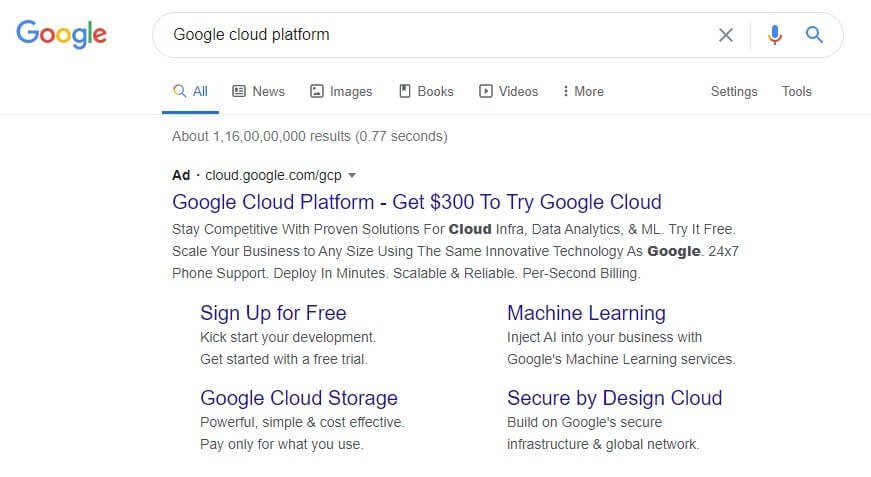
On the next screen, click on the option which reads ‘Get Started for Free.’ This is what you will see:
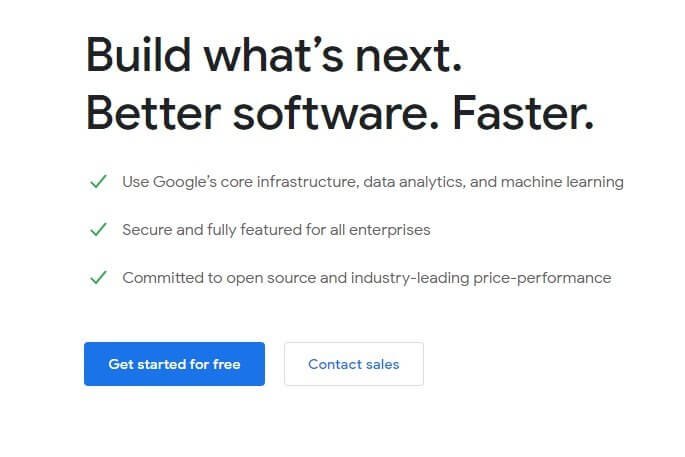
The next thing that you need to do is sign in using your Gmail account. Once you sign in, this is what you will see:

Notice that you will have to provide your credit card details, but Google explicitly says that it will not charge you after the free trial ends until you manually upgrade. That’s a lifesaver! Google will need your credit card account simply to verify that you are not a robot.
Once you add your credit card, Google will deduct $1 from your credit card. That’s all that you pay for getting started.
Once you create an account, this is the page you will see:

That’s quite intimidating, to say the least. On the top left-hand corner, you will see the default project that Google creates for you. This is what you will see:
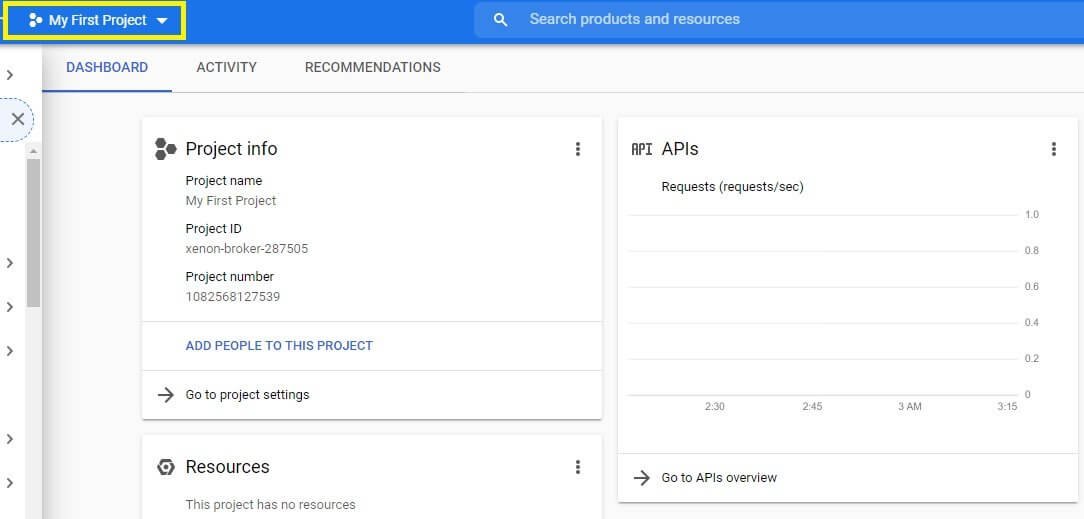
Clicking on the default project will take you to the next web page to search for an existing project or create a new project. It will also show you the list of existing projects.
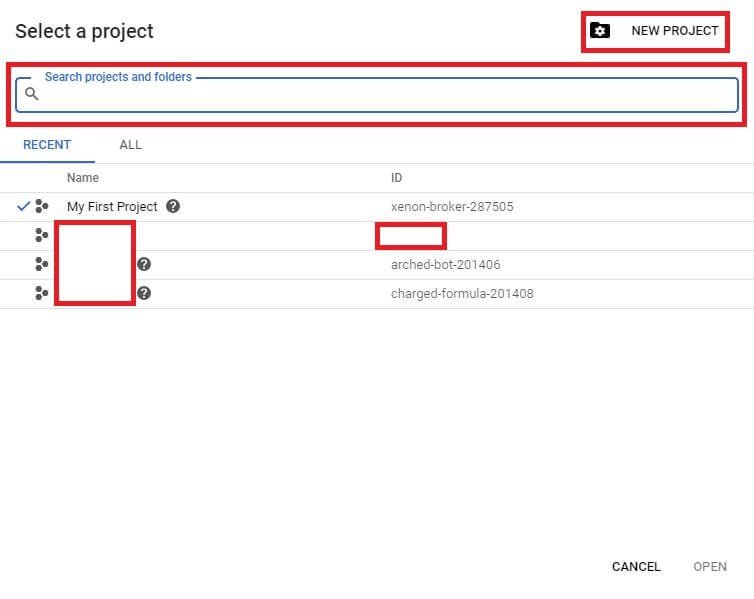
Since I want to create a VM instance, I will hover my mouse on the Compute Engine option on the left menu and click on VM instances. This is what you will see when you do that:

On the next screen, click on the option which reads Create. This is what you will see:
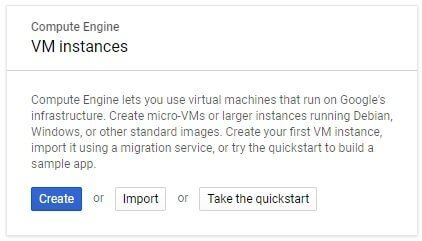
Once you click on the Create option, you will have the choice of selecting server location, RAM size, number of CPU cores, etc. Once you are satisfied with your selections and opt for an operating system, you have to click on the ‘Create’ button once more.
This is what you will see:

Once you click on the ‘Create’ option, Google Cloud Platform will automatically create the VM instance for you with your selected operating system. This is how it will look like:

The Compute Engine that you create will provide you tools to manage your SSH keys. You can see the option on the right side of the instance details. Clicking on it will provide you with several options. This is what it looks like:

Once you click on Open in the browser window, a new browser window will open with a command-line interface or CLI. This is what you will see:

This is where you can run your commands.
I selected the Compute Engine for this example. However, you can always try out the App Engine if you want to use it as a hosting solution and launch a new site or an app. For instance, you can use Google Cloud Platform as a web hosting solution for launching your new site.
Conclusion – Do I Recommend Google Cloud Platform?
Do I recommend the platform? Of course, I do! You will be using Google’s infrastructure, which is the finest in this world in uptime and security. I cannot say what will be your ultimate motive to use Google Cloud Platform.
Whatever it be, Google can give you access to one of the world’s most reliable cloud infrastructures in terms of security and data integrity.
However, do keep in mind that Google Cloud Platform is not really for rookies. It requires a great deal of knowledge to use the platform. If you have the necessary knowledge, or you know someone who can help you, the Google Cloud Platform is one of the finest that this world has to offer you. Its flexible pricing is yet another reason why you should opt for the GCP.

